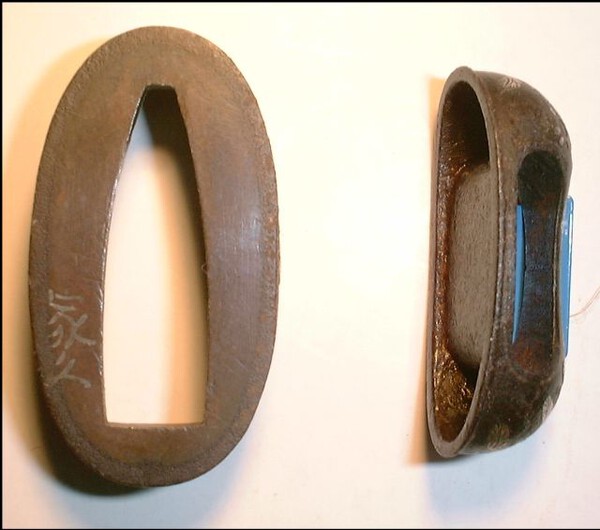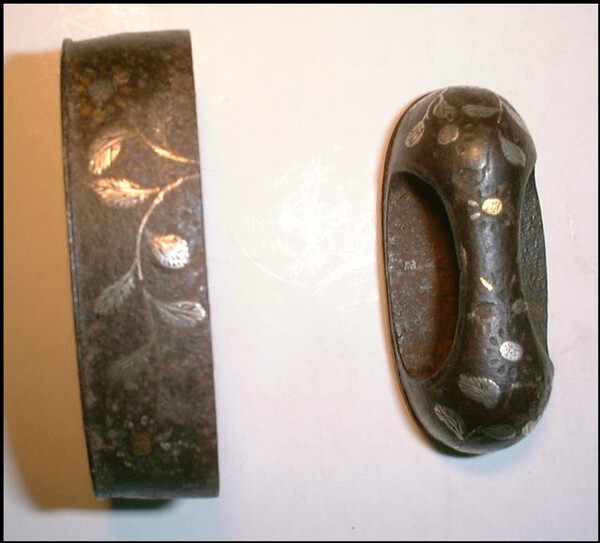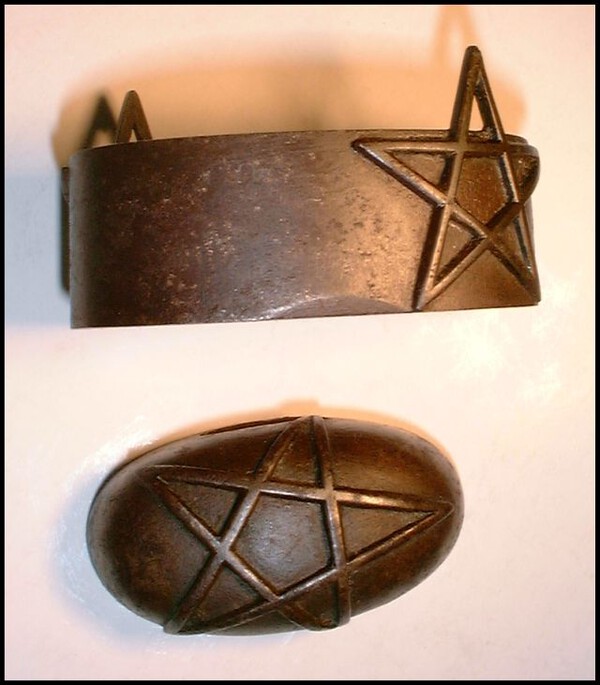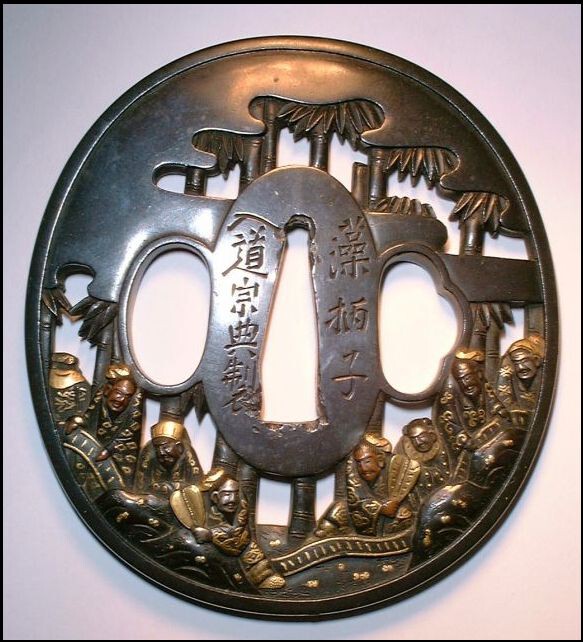-
Posts
815 -
Joined
-
Last visited
-
Days Won
1
Content Type
Profiles
Forums
Events
Store
Downloads
Gallery
Everything posted by docliss
-

Tsuba translation - mei, nengo and hakogaki
docliss replied to Ray Singer's topic in Translation Assistance
Thank you, Ludolf, a term I was not familiar with. John L. -

Tsuba translation - mei, nengo and hakogaki
docliss replied to Ray Singer's topic in Translation Assistance
Thanks again, Ludolf, but if the tsuba is signed Ikkin by his daughter then it is surely, by definition, gimmei? John L. -

Tsuba translation - mei, nengo and hakogaki
docliss replied to Ray Singer's topic in Translation Assistance
Dear Ludolf There appear to be two possible explanations for the mei and kao on my tsuba. That it is a gimei Ikkan tsuba, erroneously attributed to Ikkin I by Kamiya Mon’ichiro, or that it is a shoshin tsuba by Ikkin I, using an alternative kao, very similar to that illustrated as an alternative kao for Gōtō Ichijō on pp. 24c and d of Kinkō Meikan. John L: -

Tsuba translation - mei, nengo and hakogaki
docliss replied to Ray Singer's topic in Translation Assistance
... or by the shodai himself? John L. -

Tsuba translation - mei, nengo and hakogaki
docliss replied to Ray Singer's topic in Translation Assistance
Ludolf, thank you for your as always valuable contribution. As a clarification, the Ikkin tsuba is now mine, having recently been purchased from Ray. But do not the dates of 1838 and 1848 on these two fittings exclude Ikkin II, who was born in 1840, and only used the Ikkin name after 1864? And was he ever appointed Hokkyo? John L. -

Tsuba translation - mei, nengo and hakogaki
docliss replied to Ray Singer's topic in Translation Assistance
Thank you very much, Morita, for that information. John L. -

Tsuba translation - mei, nengo and hakogaki
docliss replied to Ray Singer's topic in Translation Assistance
Thank you so much for your prompt reply to my request, but I would still like to identify the origin of this hakogaki. Is any member able to identify the seal, I wonder - perhaps of the Museum of Japanese Sword Fittings? John L. -

Tsuba translation - mei, nengo and hakogaki
docliss replied to Ray Singer's topic in Translation Assistance
To resurrect an old thread … Would any kind member care to comment upon the attached hakogaki. I am interested in identifying the source of this. With thanks, John L. -
What a delight to find a member who is willing, and anxious, to learn. Good luck, and have lots of fun Charles. John L.
-
Here are two iron fuchi-gashira for the purists. The first is a heavy pair of polished iron, bearing a high relief, pentagonal star, one on the kashira and two on the fuchi. The apices of the latter two are raised above the upper margin of the kashira. The fuchi is inscribed TEMPO JU SAN MIDZUNOYE TORA NEN SEIKA KISSHIN (1842 A Lucky Day in Mid-Summer). The second, also, is of iron. The fuchi, with a delicate, raised rim, is tsuboguchi-gata while the kashira, also with a raised rim, is natsume-gata. Both are decorated with hira-zōgan sprays of chrysanthemums, the stems and leaves of silver and the blossoms with alternate gold and silver centres and petals; the leaves have kebori veining. The fuchi is signed, in silver hira-zōgan, IEHISA. Although very Higo-esque in appearance, this pair is probably by Kitamura Iehisa I or II, working in Kaga in 1650-1700. Both artists are noted by Haynes as using silver hira-zōgan on tsuba and abumi. John L.
-
There is a remarkable similarity between the two tsuba posted by Mike Y and Pete K and, apart from the fact that both artists were working in Higo in the second half of the C19, there appears to be nothing to link them. Can we be certain that Mike’s tsuba is, indeed, by Kobayashi Takatada and is not another by Tsuge Yoshikatsu? John L.
-
Curtis, since it looks like iron, and since tsuba bearing this mei are invariably of iron, your tsuba is probably of iron. But you can always confirm this with the application of a magnet. John L.
-
Dear Stu 1) Hikone bori Inscribed SOHEISHI NYUDO SOTEN SEI GOSHU HIKONE (NO)JU Probably nineteenth century Aizu Shōami work. 2) This mei is very difficult to read ? SHU (NO)JU TOMO ? Possibly nineteenth century Chōshū work. 3) Inscribed ECHIZEN (NO)JU KINAI SAKU Nineteenth century Kinai work. John L.
-
See http://www.aoi-art.com/fittings/tsuba/F12314.html for a similar example. John L.
-
Am I correct in my suspicion that the indentations on James' tsuba, rather than being kokuin, are caused by the loss of previous inlay? John L.
-
These two Kuni - Nanigashira artists, both working in the province of Bushū in the eighteenth century, must surely be related in some way. That there should be two independent, Fujiwara artists in this Edo Itō dominated area at this time, both producing work quite unlike its Tokugawa Shōgunate - supported norm, is extremely improbable. Haynes lists both of these artists. Fujiwara Kunimichi (H 03613.0) is described as working in Bushū ca 1775-1800, and as ‘seeming to be an artist with training in Kaga style inlay’. Fujiwara Kunishige (H 03649.0) is described as working in Bushū ca 1700; Haynes notes that, ‘although said to be of the Shōami school, his style is closer to that of a Kaga school, or the Umetada school’. A suggestion by Hara that this artist worked in Iyo province, on the Northwest coast of the island of Shikoku, has never been confirmed by a known mei. The Iyo and the Shōami connections that have been variously mooted raise the possibility of an Iyo Shōami connection for these artists. Nihon Tō Kōza, on pp.83-4, lists the names of Iyo Shōami artists, and one of these, Kunizumi, is listed by Hayne as Kunisumi (H 03663.0), a member of the Fujiwara family and working circa 1775-1800. Is there a connection here, one wonders. The characteristics of Iyo Shōami work in these three tsuba, together with the wide, suhama-gata ryō-hitsu cause one’s suspicions of the Iyo Shōami group as a source of influence upon these Bushū tsuba to persist. The impression of a Kaga influence also persists. The Koichi Kuninaga branch of the Kaga ha contains a large number of artists whose names commence with the kanji for ‘Kuni’, but there is no evidence that any of these left their home in the province of of Kaga in order to found a new school in Bushū. No Umetada connection has been found. In a vain attempt to trace a Fujiwara family line, I searched Haynes’ Index … for all of the family members who had ‘Kuni’ as the first kanji of their name. There were eight such artists, but only one, F. Kuniharu (H 03562.0), working in Bushū ca 1700, was ascribed a family relationship - in this case to F. Kunishige (H 03655.0), an artist described by Haynes as of the Bushu Kunihiro (H 03588.0) group. But this latter group is clearly quite distinct from the group under discussion here. John L.
-
Michael, two beautiful and very interesting tsuba. Thank you. John L.
-
Ian, Not a papered example, but probably as good a one as you will see. Ref. Inami: Collection Farenhorst, Nihon Tōken, Tokyo,1969, pp.62-65. John L.
-
I suspect that Alex’s fuchi is yet another version of the Chikurin shichi Kenjin (the Seven Sages in the Bamboo Grove). It is a not particularly good, Sōten style depiction of the theme, and probably dates from the early C19. Several previous threads in the NMB have dealt fairly comprehensively with Sōtenesque work. John L.
-
Lance’s tsuba is signed YUMYOKEN MASAHIRO with kao. This artist is listed as H 03997.0 in Haynes’ Index …, and the kao is shown under M72 in Shōsankenshu: he was working in Kōfu around 1860. A tantō tsuba by this artist is included under the unclassified, signed pieces in the Catalogue of the Baur Collection as D2223, with an illustration on p.329. This is the same tsuba as #2547 in the Naunton Catalogue, illustrated on pl.X, dated 1860, and ex the Hawkshaw collection. Presumably the entry in Shōsankenshu was taken from this tsuba. The Victoria and Albert museum also has an undated example of this artist’s work, M2051-1931. This is a very nice, matching set of fittings. John L.
-
Ron, thank you for posting the images of your very fine tsuba. It is, as you say, signed BUSHU (NO)JU KUNIMICHI SAKU, and is certainly the work of Fujiwara Kunimichi (H 03613.0). Although working in Bushū ca 1775-1800, the decoration makes one think of a later date. In the K257 entry from Shōsankenshu, almost certainly taken from Hawkshaw’s tsuba, Joly notes ‘Jochiku inlay’. This is sumie-zōgan – a dark, shakudō hira-zōgan inlay on a light-coloured surface such as shibuichi or copper, which resembles ink painting and is present on the dote mimi of your tsuba. I have been unable to find any other work by – or reference to – this artist, but your example of his work is quite unlike that which is normally accepted as Bushū. With its fine treatment of the soft-metal plate; its hira-zōgan decoration; its broad ryō-hitsu; and without its mei, it would probably be attributed to the Akita Shōami, Umetada or Murakami schools. A beautiful tsuba…. John L.
-
Mark’s fuchi is signed NAOTOSHI with kao, and Haynes lists no fewer than nine artists using these kanji. The kao is most like that of Hamano Naotoshi (H 06807.0), working ca 1775, and it should not be too difficult to identify the artist, who used a variant of the ‘Nao’ kanji with the third horizontal stroke of the 目 turned vertically. This fuchi is certainly not a pair to the kashira, which is possibly late Mito work. John L.
-
Just as a post-script, Kinkō Meikan, on p.5d, illustrates a mei, the second kanji of which differs from that on Ian’s tsuba, and does not show a kao. John L.
-
I agree that AKIMASA (H 00041.0) is the only artist listed in Haynes who used these kanji, but the kao listed there is quite unlike that on Ian’s tsuba. ? a different, and unlisted, artist. John L.
-
This book can be obtained here: http://www.japaneseartswords.com/node/84 John L.






